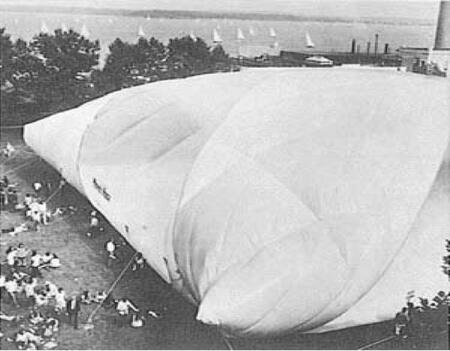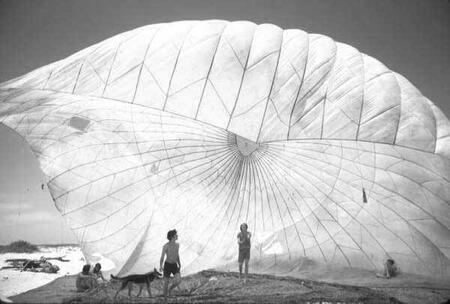Table of Contents
pneumatology
[pneumatology: from pneuma, meaning air, wind, spirit, soul]
by Cocky Eek - 2008
This research is written in the context of foam's multireal and real worlds:
MultiReal: 'translocal': Art in uncertain conditions
–> guerrilla art-forms – portable, robust, low-tech, recyclable media, materials and technologies that can adapt to a variety of conditions. How can we make works such as responsive environments more mobile, easy to unpack, even pocket-size (inflate as needed)? how can we make such works accessible to people without galleries and black boxes - in the middle of the desert, or a jungle, or in an urban ghetto? is this type of art and tech needed at all? (think of modular tech and architectures, cheap technological solutions for providing full-body participatory media experiences, portable and soft architectures…)
Real: 'levitating': 'off the ground' & 'out of this world'.
–> from extreme sports to extreme arts, (sometimes) defying the laws of physics. experiments in wind tunnels and zero-gravity, under-water and hanging from cliff-tops. have the arts become too tame and too self centered? has everything already been experienced? can arts still provide excitement and surprise as they used to when they were more in tune with what society experienced in everyday life? What games to we want to play in a world of mixed realities? (small performances and public interventions, expeditions and playgrounds)
while working on this research, I have scanned three design principles of gRig:
sustainability
playfulness
modularity
Lightness as a state of being
Around our contemporary environmental questions at least one thing became clear to me and that’s that out of fear, or to build on top of our guilt, we can’t create anything. So instead I rather like to slide the heavy burden of my shoulders and choose the quality of lightness. Italo Calvino underlines this quality as one of his ‘Six Memos for the Next Millennium’, in here he describes a scene from Cernavantes’ novel, leaving me with an unforgettable impression of lightness, in which Don Quixote drives his lance through the sail of a windmill and is hoisted up into the air. And I wonder can we construct our worlds from this lightness. Imagine a life more light and imagine it to be constructed more mobile, flexible, portable, organic and more related to our natural surroundings and the elements, and that we can create our homes or shelters wherever our heart is with no fixed form or any beginning and end, either spatially or in time.
The Renaissance embodied the idea of air or better ‘pneuma’ [wind, air, breath, spirit and soul] in their art of building. One of the primary goals of renaissance architects was to enhance the powers of pneuma so as to foster the art of well-being, essence, wind and ventilation were core principles of classical buildings. Pneuma was a wonderful link for establishing harmony between the human body, architecture and the cosmos, and that building was envisioned as a mediator between the inhabitant's soul and the -anima mundi-, the soul of the world. This indicates a link to contemporary environmental questions. Philibert Delorme's [French Renaissance architect 1514 -1570] describes that -the prudent architect is fully utilizing all his senses, and explains that the sense-less architect has “little nose” because he does not have the intuition of good things-, is evidence that the pneumatic architectural imagination is multi-sensorial. Renaissance notions of pneuma revealed a concern for the connectedness of person and place where architecture can refine the qualities of air to.
And in wondering if we can construct our worlds from the lightest quality surrounding us everywhere: –air- inflatable architecture comes the closests. Its thin flexible membrane, acts as a space-defining skin is able to give shape of –air- itself allowing it to be a breathing unity with its own integrity. Its close related to its surrounding its specifically bodily and tactile by nature and its portable, mobile, and playful.
Before we continue…
What kind of inflatables are we talking about...
The main quality of these inflatables is that they are alive. In such a way that it are inflatable spaces you want to be emerged with, play with, be involved with and for the rest:
- They have a scale somewhere between our second, and third skin (ps. the first skin is our own skin, the second skin our clothes, the third skin our rooms and buildings.)
- They have a nomadic character, in such a way that they are mobile or portable
- They can be seen as breathing living organisms in which their visitors can become co-structures of a space.
And who can create these kind of inflatables
We imagine that one has to be an expert to create these objects, with a few marks of the pencil, worked out laboriously at the computer. But to respect the individual who is not an expert precisely for his lack of expertise. Often people in this state of being are in a position to give free rein to change. The danger is that experts can’t do that anymore, because he’s already learned how things ought to be done, unless he gives up his own ideas and opinions. Everything that is inept, wayward, intuitive, instinctive and emotional, and emerges from ourselves- that is the expertise of the non-expert. Once the individual can go his own way, free of rules and regulations, diversity occurs, because new solutions are constantly being found.
The 1,2,3 recipe for an inflatable space
With the most common cheap plastic one can make in less then one hour an inflatable space. One can simply tape, stitch or iron the layer plastics together, make a hole and mount a table-ventilator and voila there is an inflated space. To enter the space; take a knife and make an incision. Its a quick medium to construct a space, one can practice building over and over again, every time deepening its patterns, until you know exactly how to realize spaces which works.
Some general problem domains in contemporary architecture
Juhani Pallasmaa’s described in -The Eyes of the Skin- some general problem domains in our contemporary architecture:
- The current over-emphases of intellectual and conceptual dimensions of architecture contributes to the disappearance of its physical, sensual and embodied essence.
- While computer design can give us new insights in architecture we shouldn’t forget that creative work calls aswell for bodily and mental identification.
- In general while our experience of the world is formulated by a combination of five senses, much architecture is produced under consideration of only one -the most dominated in our time – sight. The suppression of the other sensory realms has led to an impoverishment of our environment, causing a feeling of detachment and alienation.
The inhumanity of contemporary architecture and cities can be understood as the consequence of the negligence of the body and the senses, and the imbalance in our sensory system. Every touching experience in architecture is multi-sensory; qualities of space, matter and scale are measured equally by the eye, ear, nose, skin, tongue, skeleton and muscle, the way places feel, the sound and the smell of places has equal weight to way things look.
- During the design process, the architect gradually internalizes the landscape, the entire context, and the functional requirements as well as his/her conceived building; movement, balance and scale are felt unconsciously through the body as tensions in the muscular system and in the positions of the skeleton and inner organs. As the work interacts with the body of the observer, the experience mirrors the bodily (proprioceptive) sensations of the maker. Consequently, architecture is communication from the body of the architect directly to the body of the person who encounters the work.
- Modern architectural theory and critique have a strong tendency to regard space as an immaterial object delineated by material surfaces, instead of understanding space in terms of dynamic interactions and interrelations.
The experience of home is structured by distinct activities – cooking, eating, socializing, reading, storing, sleeping, intimate acts- not by visual impacts. Architecture initiates, directs and organizes behavior and movements. Consequently basic architecture experiences have a verb form rather than being nouns. Authentic architectural experiences consist then, for instance, of approaching or confronting a building, rather than the formal apprehension of a facade, of the act of entering and not simple the visual design of the door; of looking in or out through a window, rather than the window itself as a material object.
[reference to :There is a Timeless Way of Building- patterns of events]
more on inflatables:
- Inflatable Inspirations: 15 sections of visual -Inflatable Inspirations-. Each section by far don't give a complete overview in its field but I hope all works are, in one way or another, inspiring and can lead to new vibrations…
- Pattern_language A summary of Christopher Alexander’s -Pattern Language- to create a timeless way of building. This pattern language is based on the actions which takes place in space and time which makes one feel “alive”.
- An Inflatable Pattern Language: A despription of the patterns based on the structures of `The Architects on Air (UK), which can be useful for anyone interested in building ‘living inflatable structures’.
- Design Considerations For Inflatable Structures: the most common obstacles one comes across in inflatable structures are mentioned. No solutions will be given to any design problem, but some suggestions will be given so now and then…
- Inflatable Links: An inventory of links for innovative inflatable- manufacturers, research labs, producers and other people working with inflatables both from the artistic and in the technological field, and links with innovative inflatable architecture, objects, & robots
- [Related reading notes: The Timeless Way Of Building by Christopher Alexander, Cradle to Cradle by William McDonough & Michael Braungart, The Eyes of the Skin by Juhani Pallasmaa]


